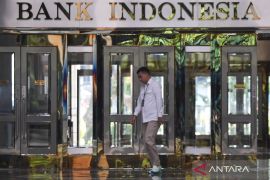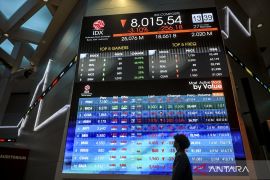The country's foreign debt growth was recorded at 3.8 percent year-on-year (yoy), sliding from 5.1 percent yoy in the previous quarter, chiefly influenced by private external debt repayment transactions.
The government's external debt was recorded at US$197.4 billion, or grew by 1.6 percent yoy, decreasing from 2.1 percent yoy in the previous quarter, Executive Director of the Communication Department of Bank Indonesia (BI) Onny Widjanarko noted in a statement here on Monday.
The slowdown in growth is in line with the foreign investors' adjustments to portfolios in the Indonesian Government Securities (SBN) market owing to high level of uncertainty in the global financial markets.
However, the slowdown in external debt was restrained by the issuance of Samurai Bonds in the Japanese financial market and withdrawal of some loan commitments from multilateral institutions in the third quarter of 2020, which is part of the government's strategy in maintaining the financing portfolio to tackle the COVID-19 pandemic and implementing the National Economic Recovery Program (PEN).
The government's foreign debt, managed in a careful, credible, and accountable manner, to support priority spending was aimed at raising funds for the health services sector and social activities, which accounted for 23.7 percent of the total government foreign debt; the construction sector, which had a16.6-percent share of the total government debt; education services, 16.5 percent; the government administration sector, defense, and compulsory social security, 11.8 percent; and the financial services sector and insurance, 11.5 percent.
Meanwhile, the growth of private external debt at the end of the third quarter of 2020 was recorded at six percent yoy, declining from 8.4 percent yoy in the previous quarter.
This development was driven by sluggish growth in the external debt of non-financial institution companies (PBLK) and the continued contraction in external debt of financial institutions (LK).
At the end of the third quarter of 2020, PBLK external debt growth was recorded at 8.1 percent yoy, slowing down from the previous quarter's growth of 11.6 percent yoy.
Meanwhile, LK foreign debt contracted to one percent yoy, down from 1.8 percent yoy in the previous quarter.
The private sector debt was chiefly concentrated in the financial services and insurance sector, the electricity, gas, steam/hot and cold air (LGA) procurement sector, the mining and quarrying sector, and the manufacturing sector, accounting for a 77.4 percent share of the private sector external debt.
Widjanarko emphasized that the structure of Indonesia's external debt remains healthy, supported by the application of the precautionary principle in its management.
The ratio of Indonesia's external debt to the gross domestic product (GDP) at the end of the third quarter of 2020 was 38.1 percent, a slight rise from 37.4 percent in the previous month.
Indonesia's foreign debt structure was considered to be healthy, as reflected in the largest component of the long-term external debt, with a share of 89.1 percent of the total external debt.
Related news: Foreign debt grew at sluggish pace in July 2020: BI
Related news: Rupiah to weaken over sentiment arising from debt-sharing policy
Translator: Fardah Assegaf
Editor: Rahmad Nasution
Copyright © ANTARA 2020












